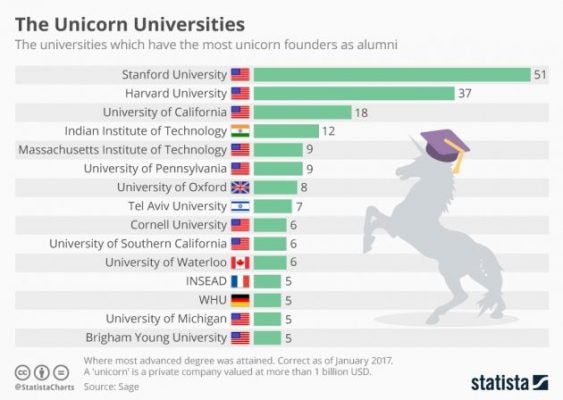
Universities claiming unicorn company founders
To be considered a unicorn, the private business must reach a valuation of at least one billion dollars, and that’s no small feat

To be considered a unicorn, the private business must reach a valuation of at least one billion dollars, and that’s no small feat
By Larry Kim Faculty of EngineeringBecoming a founder of a unicorn company is a dream that many entrepreneurs hope to achieve.
To be considered a unicorn, the private business must reach a valuation of at least one billion dollars, and that’s no small feat.
People often attempt to break down what it takes to become a unicorn founder. While hard work and dedication are usually assumed requirements, along with a stellar concept, everyone knows that it takes more than that to reach the stars.
A recent chart was released that hoped to shed some light on the question, showing which universities can claim the most unicorn company founders as alumni.
Here’s what it had to say.
Statista used data from Sage to create an infographic showing which schools come out on top in regards to molding unicorn founders. The included educational institutions hail from all around the world including, but not limited to, the US, India, England, Israel, and Canada.
The top school on the list, Stanford University, claims 51 unicorn founders as alumni while runner-up Harvard University has 37. Rounding out the top three is the University of California with 18.

Stanford University’s unicorn founders include Elon Musk as well as Sergey Brin, Larry Page, and Evan Spiegel. Harvard was at one point home to Mark Zuckerburg, Jason Kilar, and Mark Pincus while Travis Kalanick, Nicholas Woodman, and Logan Green all spent time at the University of California.
Arash Ferdowski, Drew Houston, and John Perritt attended MIT and Andrew Trader hailed from the University of Pennsylvania.
It should be noted that the data focused on where the person achieved their highest-level degree or they participated in their most recent educational pursuits, so many of the people included in the analysis may have attended other institutions along the way. For example, Elon Musk attended Stanford but did not complete the program.
Additionally, there are other schools that have played a role in the lives of unicorn investors whose alma maters didn’t reach the top 15, so, even if you didn’t attend one of these institutions, that doesn’t mean you can’t achieve unicorn status.
I, myself, am a graduate of the University of Waterloo, Faculty of Engineering, Electrical and Computer Engineering, which is the 11th school on the list of unicorn universities. One day soon, I hope to be able to take my place as a unicorn founder, doing my part to bring the University of Waterloo up a bit in the listings and joining the ranks of other notable unicorn alumni like Ted Livingston and Christopher Best.
This story was originally posted on December 13, 2017, by Medium.com
The author of the post, Larry Kim graduated with a BASc in Electrical Engineering in 2000. He is currently the CEO of Mobile Monkey and founder of WordStream. You can connect with him on Twitter, Facebook, LinkedIn and Instagram.
The six founders that the University of Waterloo note as Unicorn companies are Kik Interactive co-founded by Ted Livingston and Chris Best, Instacart founded by Apoorva Mehta, Wish co-founded by Danny Zhang and Peter Szulczewski, and Jasper founded by Omid Aminfar.

Read more
Waterloo Engineering community honours impact and innovation at annual awards dinner

Read more
Meet five exceptional Waterloo graduate students crossing the convocation stage as Class of 2025 valedictorians

Read more
Twenty-six researchers receive federal funding to drive discovery, innovation and research infrastructure development
Read
Engineering stories
Visit
Waterloo Engineering home
Contact
Waterloo Engineering
The University of Waterloo acknowledges that much of our work takes place on the traditional territory of the Neutral, Anishinaabeg, and Haudenosaunee peoples. Our main campus is situated on the Haldimand Tract, the land granted to the Six Nations that includes six miles on each side of the Grand River. Our active work toward reconciliation takes place across our campuses through research, learning, teaching, and community building, and is co-ordinated within the Office of Indigenous Relations.